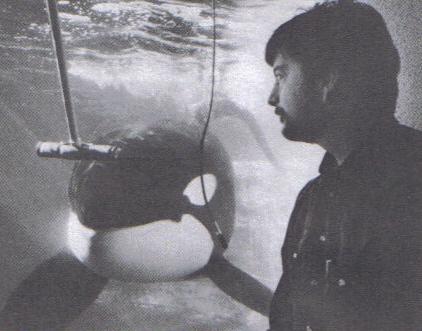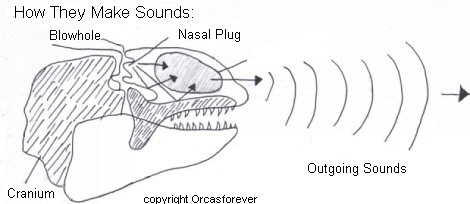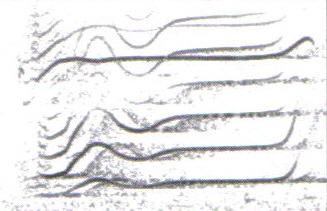

One of the most intriguing aspects of the killer whale's life is the amazing calls it will make. Everyone's heard whale calls. But do you know who you heard?
Orca 'dialects' have lead to us unlocking some of the most fascinating secrest of their societies. But how do they make these amazing sounds, considering they don't have vocal chords? And what do they mean to say, when they make such varieties of clicks and whistles? What's the difference between echolocation and communication? And how do they hear, anyway?
If you have ever asked yourself any of those questions, or you haven't but reading them right now makes you want to know the answer...hey, even if you have to read this for a project for school, this page can answer those questions!
But before we get into communication, let's start with hearing:

Above is a ridiculously large illustration of how a killer whale hears. Granted, it's a pretty simple version, but I'm assuming we're not all expert killer whale researchers, right?
And before we go on, might I add that this drawing was done by ME! I worked long and ridiculously hard on it (it may not look complicated, but that's what I thought too...), and if anyone just takes it without my permission, I won't be very happy. However, if you ask me, 99% of the time I'll say yes.
Ok, moving on. How does a killer whale hear? Well, before I answer that, let me say yes, they do have ears. Tiny, tiny, tiny ears, the size of pinholes. But the sound doesn't go in the ears. And that's where this drawing comes in.
The lower jaw of an orca is hollow, and within this jaw is a body of fat (see fat body in jaw, on the drawing). The lower jaw is incredibly important to the hearing of a killer whale. The area at the base of it is flat, and acts like an eardrum acts for us, even though they also have a real eardrum. Another word for the jaw is the acoustic window.
The incoming sounds (see incoming sounds) come through the jaw, get picked up by the fatty tissue, and are carried to the middle/inner ears, which are at the hinge of the lower jaw.
This complicated process means sound eventually reaches the actual earbone, which yes, actually has an eardrum. The earbone is the hardest bone in the whale's body, and is surrounded by gas-filled tissue. It is also dislocated from the skull.
The gassy tissue surrounding the ear means that the ear doesn't pop or anything, when the whale dives and the pressure changes. It also makes it easy for the whale to realize where the sound is coming from.
Finally, all of this results in exceptional hearing. While people can hear sounds as high as 15-20 kHz (kilohertz), whales can hear sounds up to 110 kHz!

Now we get a little trickier. How do they vocalize?
Once again, the drawing above is done by ME. This one took even LONGER, amazingly, so I really would appreciate you contacting me before you use it.
Ok, so vocalizing. Just like orcas don't hear the same way we do, they don't make sounds the same way. They don't open their mouth and 'talk'. This is because...they don't have vocal chords! That's right. So how come they're still some of the noisiest animals?
Well, fatty tissue saves the day again!
When an orca wants to make a sound, it shoves air through structures in the nasal passage (below the -closed- blowhole). The air creates the sound, which goes to the big body of fat known as the melon. The melon is like an acoustic lens; it focuses the sounds and directs them. Very useful!
Echolocation takes a different method. Echolocation, which is heard as sharp clicks, like rapping on wood, although very fast, is made by opening and closing a muscle. This muscle makes a popping sound, AKA the rapping on wood sound, and is located below the blowhole as well. Echolocation is also projected through the melon.

Above is a fairly quickly drawn and very rough sketch of an orca using echolocation and 'seeing' a fish (nice fish, isn't it? lol). As terribly drawn as it is, it is still mine. Ask before using, you know the drill...
So. Echolocation. Echolocation is made, as said above, by opening/closing/opening/closing etc this muscle that goes pop.
When listening on a hydrophone, the sound of echolocation is very easy to identify; it sounds like someone rapping on wood, or clicking something. Sometimes it is very rapid, sometimes slower. But what is it?
Orcas echolocate when they can't see at all, or are having trouble getting around. Actually, they mostly use echolocation when they're hunting.
Also called sonar, echolocation works like this: Orcas make the sonar clicks, using various rates and frequencies, and the sound radiates out from the melon. If the sound hits something, an echo of that something bounces off and goes back to the whale. By using these echoes and clicks, the whale can get a sort of photograph of its surroundings, enabling it to get around and find the fish, even when visibility is poor.
Residents are mostly the types of orcas that use this technique. Transients tend to avoid it, because their prey has good hearing and might pick up on them.
Orcas are also not the only ones to use echolocation. Many dolphin species do it, as do bats.


Above, on the left, is something NOT drawn by me! Lol on the left is a spectogram of the N2 call, and on the right, the N32 call. For more info on these calls, keep reading. Both were scanned from the Blackfish Sounder, Issue 6.
Besides echolocation, orcas in the Pacific Northwest use two other types of calls: One type, very high frequency whistles, often occurs (loudly) during social interactions, perhaps meaning excitement, or just a very loud way of greeting another whale. We don't yet know what these whistles are for. The third type, the discrete calls, are what this part of the page is on.
Discrete calls are vocalizations that are a certain length and tone. Each pod of resident orcas has its own set of discrete calls-together, the calls make up the pod's dialect. The dialect is like the language of the pod; only members of that pod use the calls, and since it stays in the family generation after generation, dialects often change very little over the years. In the Southern Residents, the J-pod dialect has especially remained unchanged. Moby Doll, the first captive orca, used practically the same discrete calls in 1964!
Since only certain pods use certain calls, researchers can use these calls to figure out which pod they are listening to. Thanks to the discrete calls, researchers can listen to practically any group of whales calling and know which whales they're listening to! Often, matrilines also form discrete calls. For example, the A1 pod shares discrete calls, but in the A12 matriline, there is one call in particular that seems to have become their trademark.
Also, dialects serve the useful purpose of establishing the family history. Researchers have discovered that the more similar the dialect between pods, the more closely the pods are related. This also serves as a way for orcas to avoid inbreeding. Since they have such tight familial bonds, researchers assumed inbreeding was a problem. But the orcas had it all figured out! By listening to the dialects, they know how closely another whale is related to them. Therefore, the bigger the accent, the more appealing the mate!
This is how the clans are figured out. Every pod in a clan shares discrete calls that are very similar to each other. The sounds between clans are very distinct. In the G-clan, there is a distinctive and fun to hear 'ping' sound, while the R-clan just branches out and sings these really awesome whistles. The A-clan seems to settle into the whale calls we are used to hearing.
Besides all these useful jobs the discrete calls provide researchers with, they also serve a purpose in orca-land. Used mostly for communications between whales, they are a useful way to stay in touch with your family, considering they can be heard 10 km away! And it's an easy way to figure out who's your aunt and who's a transient.
Spectograms (above) are used to decipher the code of killer whale calls. Spectograms are sort of photos of sound, recording the energy and frequency of sound. Taking measurements of length and height of the spectograms of calls helps researchers to tell which calls are which. Thanks to spectograms and the marvelous machinery of computers, over 100 call-types have been identified. A call type is assigned a number after an N.
The spectograms above show two calls, each from a different clan. The first, the on the left, is the N2 call. The N2 call comes from the A8 matriline in the A5 pod, which is in A-Clan. The second, on the right, is the N32 call, which is made by the R1 pod in R clan. See how they're pretty much completely different?
Meanwhile, what's going on with the transients? Well they tend to stay silent, since their prey pays attention to sound, but when they do vocalize, everyone knows! The sounds transients make are completely unique and very different from residents, anyone can tell them apart. Since transients have less strongely connected pods, all transients tend to share the same calls. Sometimes, differences pop up in different regions, but not within pods.